|
Addicted to the Holiday Season
by Bob Brooke
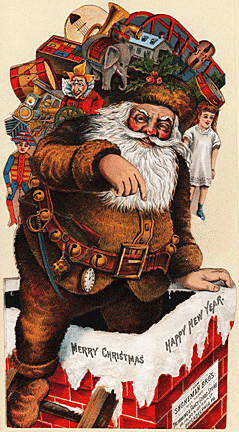 Are
you addicted to the holiday season? Lots of people are. And those who
arenít addicted to Christmas are to Halloween. Both offer a great
opportunity to start collections that donít cost a lot of money. While
Halloween focuses on the spooky and the supernatural, Christmas focuses
on warmth and good cheer. And since Halloween is but a memory to many by
now, letís take a look at what the yuletide has to offer in
collectibles. Are
you addicted to the holiday season? Lots of people are. And those who
arenít addicted to Christmas are to Halloween. Both offer a great
opportunity to start collections that donít cost a lot of money. While
Halloween focuses on the spooky and the supernatural, Christmas focuses
on warmth and good cheer. And since Halloween is but a memory to many by
now, letís take a look at what the yuletide has to offer in
collectibles.
To antiques collectors, thereís more to Christmas than trappings and
wrappings. It offers yet another opportunity to add to their
collections---or those of others. Some collect all things Christmas year
round while others wait until Thanksgiving to pull out their lights and
garlands and drape the homes in yuletide splendor.
While it may be a bit chilly for flea markets, antique malls overflow
with all sorts of yuletide collectibles, so many in fact, that it may be
hard to decide what to collect.
Ornaments
 Topping
the list are ornaments. Everyone has a favorite ornament, the one that
harks back memories of a childhood tree, dripping with lead tinsel and
blown glass beauties. Topping
the list are ornaments. Everyone has a favorite ornament, the one that
harks back memories of a childhood tree, dripping with lead tinsel and
blown glass beauties.
Collecting Christmas tree ornaments can be addicting, but it can also be
satisfying. Some collectors prefer glass ornaments from the turn of the
century to the 1930s. Others seek boxes of gleaming Shiny Brite balls
from the 1940s. You can easily find them at flea markets, estate sales,
and antique malls. A 12-piece set of colored balls sold for around 63
cents in the early 1940s. Today, a mint-inbox original set could bring
$35 to $70 or more, depending on its design.
Whatever the style, you can start a respectable collection of vintage
Christmas ornaments quite affordably. But price isn't really the issue.
For most itís the memories of
all those Christmases together.
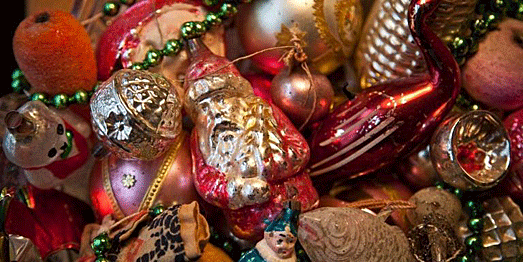
Even if you have been collecting ornaments for a short time, they will
begin to pile up, so how to do you display your collection? You could
separate them into groups based on age, design, subject matter, etc.
Then you can decorate your holiday tree each year using a different
group as a theme. For instance, you may have an antique ornament tree, a
Victorian tree, a vintage ornament tree, or a modern tree. You could
even have a tree decorated with annual ornaments like the ones that
Hallmark Cards produces each year. Whatever you decide, youíll have lots
of fun not only collecting them but displaying them.
Celluloid
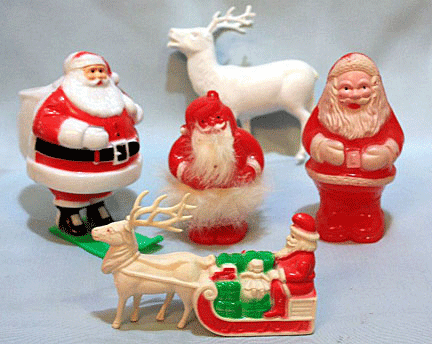 When
it comes to the holidays, few people can argue the charm of celluloid
figures. The delicate, blow-molded Santa Clauses are among the most
coveted by collectors. Yet tons of variations in size, style, and
manufacturer make celluloid Santas an easy-to-find, and often
affordable, collectible. While celluloid existed as early as 1896, the
small, hollow blow-molded toys began appearing in the United States from
just prior to World War I to around the Depression. When
it comes to the holidays, few people can argue the charm of celluloid
figures. The delicate, blow-molded Santa Clauses are among the most
coveted by collectors. Yet tons of variations in size, style, and
manufacturer make celluloid Santas an easy-to-find, and often
affordable, collectible. While celluloid existed as early as 1896, the
small, hollow blow-molded toys began appearing in the United States from
just prior to World War I to around the Depression.
The American Viscoloid Company was the most prolific, beginning its
celluloid toy making in 1914. Crafted by a German designer, these Santa
figures have a German visage. "Those are so highly collectible,"
Robinson said.
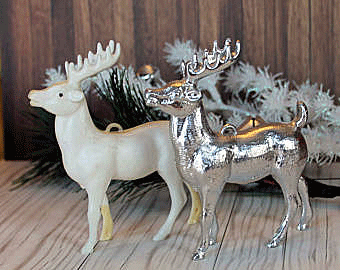 While
vintage examples made in America, Japan and Germany are charming, all
are also marked with a manufacturers' name or mark. The key to value is
their size and detail. While
vintage examples made in America, Japan and Germany are charming, all
are also marked with a manufacturers' name or mark. The key to value is
their size and detail.
The larger celluloid figures get, the more expensive they are. Small,
three-to-five-inch standing Santa figures from Japan sell for $25 to
$45. More ornate examples such as a Santa by a chimney, riding a
vehicle, holding a dog, etc., bring much more. Santa riding a zeppelin
is one of the most, notable pieces and can sell for as much as $700 or
more.
Postcards
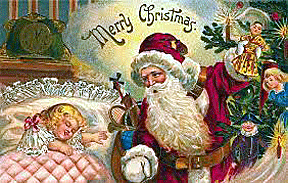 During
the first decade of the 20th century, people sent Christmas greetings by
regular mail in the form of postcards. Colorful postcards depicting
Santa Claus, snow scenes, trees, angels and children were common.
Collectors especially like adorable children in period clothing and
Santas ranging from jolly to stern. During
the first decade of the 20th century, people sent Christmas greetings by
regular mail in the form of postcards. Colorful postcards depicting
Santa Claus, snow scenes, trees, angels and children were common.
Collectors especially like adorable children in period clothing and
Santas ranging from jolly to stern.
Santa Claus in a red robe is a common image on vintage postcards.
Collectors seek postcards showing Santa wearing robes of different
colors. The most common and inexpensive are Santas dressed in the
traditional red robe, but collectors love to find them dressed in blue,
yellow, green or white robes. At the beginning of the 20th century,
brown-robed Santas were popular.
Lights
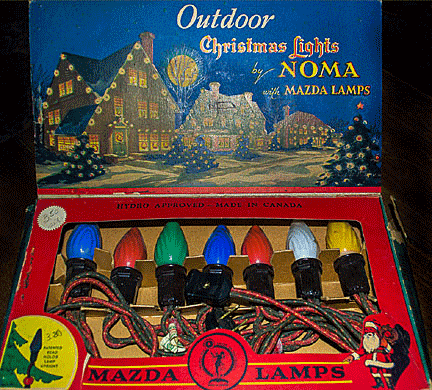 Before
the tiny twinklers on today's Christmas trees, there was NOMA. Fans of
Christmas lights need look no further for some of the most fascinating
and valuable collectibles of holidays past. While the first Christmas
tree lit by electricity appeared in 1882, the most memorable date for
collectors is 1925, when the National Outfit Manufacturers Association
formed as a trade group of 15 firms who made Christmas lights. Soon
after, NOMA Electric Corp. began marketing lights under that name. Before
the tiny twinklers on today's Christmas trees, there was NOMA. Fans of
Christmas lights need look no further for some of the most fascinating
and valuable collectibles of holidays past. While the first Christmas
tree lit by electricity appeared in 1882, the most memorable date for
collectors is 1925, when the National Outfit Manufacturers Association
formed as a trade group of 15 firms who made Christmas lights. Soon
after, NOMA Electric Corp. began marketing lights under that name.
After World War II, the industry was booming, and NOMA boxes and
catalogs became pieces of art unto themselves. Todayís collectors seek
the packaging just for its retro look. The 1955 catalog depicted Santa
dancing with a leggy reindeer while on the cover of the 1958 catalog,
Santa draped a sleeping town with NOMA lights.
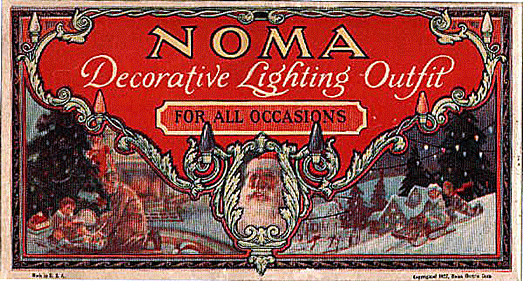
Loose sets of the NOMA lights are easy to find, but it's the boxed sets
that are a thrilling and pricey find. In an online sale, a mint-in-box
set of 1940s NOMA bubble lights sold for $150.
Figural Candles
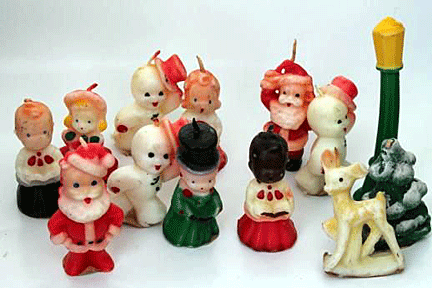 Santa
Claus warms the heart of Christmas collectors in the shape of yuletide
candles. Vintage Gurley figural candles are perhaps the best known and
coveted by collectors. Santa
Claus warms the heart of Christmas collectors in the shape of yuletide
candles. Vintage Gurley figural candles are perhaps the best known and
coveted by collectors.
Gurley also made figural Christmas candles for Standard Oil Co. of New
York in the 1930s and 1940s. That company, later known as Mobil,
introduced the red Pegasus logo, and some candles can still be found
with a paper label on their bottom, helping date the piece and adding
extra value.
Figural Christmas candles depict Santa Claus, trees, and angels, as well
as a host of other figures. The best retain their labels and shape, but
many have lost their labels after years of storage and handling. The
best can bring $15 to $20 while the smaller and more common pieces
missing their labels might bring $10 or less.
So if youíre looking for that special gift for someone, you might want
to look to the not-so-distant past for yuletide objects that will
rekindle memories.
<
Back to Antiques Extra! Archives
Next Editorial > |
